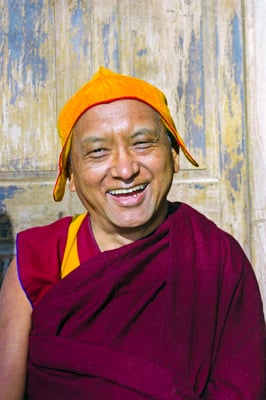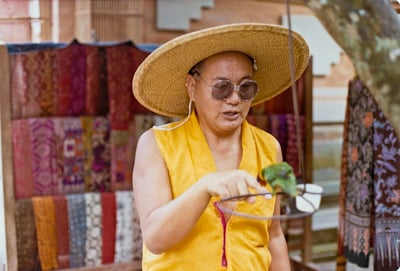Dear LYWA friends and supporters,
As 2013 comes to a close, we send our deepest gratitude to all of you who support us in so many ways: by visiting our website and spreading the word about the Archive, by sharing our books with others, and with your generous gifts in support of our work together.
Happy Lama Tsongkhapa Day!
Today, December 27th, is Lama Tsongkhapa Day, the day that Tibetan Buddhists around the world celebrate the birthday of this revered master, the founder of the Gelugpa lineage. Read more about the recommended prayers and practices for this special day, from an article published in Mandala magazine in 2002.
As you can see, it's a great day to make offerings! We invite you to take part in this special day with your year-end donation to the Archive. We are only about 1/3 of the way towards our year-end goal, so please make your donation today to help us end the year on a good note.
Lama Yeshe Video
Watch one of Lama Yeshe's Christmas talks on our YouTube channel. Over the years, Lama Yeshe would give a talk on Christmas day, typically at Kopan Monastery in Nepal. These talks were published in 1978 in the book Silent Mind, Holy Mind. This video is of a talk given by Lama Yeshe in 1982 at Istituto Lama Tzong Khapa in Pomaia, Italy.
We are also posting a series of videos of Lama Thubten Yeshe's Thousand-Arm Chenrezig Commentary, given at Vajrapani Institute in Grizzly Lodge, California in May 1980. This is an eight-part series and we'll be posting one video every two weeks.
Our eletter teaching below is excerpted from the transcript of these talks.
What's New On Our Website In this season of traditional holiday dinners of roasted turkeys and baked hams, it is good to reflect on the practice of not harming others. Lama Zopa Rinpoche discusses this in an excerpt from a question and answer session from 2009, when asked about promoting a policy of veganism.
In this season of traditional holiday dinners of roasted turkeys and baked hams, it is good to reflect on the practice of not harming others. Lama Zopa Rinpoche discusses this in an excerpt from a question and answer session from 2009, when asked about promoting a policy of veganism.
Read a teaching by Kyabje Lama Zopa Rinpoche given prior to a Vajrayogini initiation at ABC Centre, Singapore. Edited by Ven. Ailsa Cameron. The exact date of this teaching is unknown but it is possibly 1988. Then, read a teaching Rinpoche gave in Singapore in 2013, where Rinpoche explains how we will keep meeting one another again and again until we are free from samsara.
We have also just posted two short excerpts of Lama Yeshe's teachings, one on how the Buddha teachings can connect with different people needing different methods, and the other on how spiritual art symbolizes wisdom and understanding.
New Advice From Lama Zopa Rinpoche
Read a long advice from Rinpoche to a student whose breast cancer had recurred and was asking what purification practice and retreat would be most beneficial for her.
Read also Rinpoche's response to a student who cares for her mother after a series of strokes. The student wrote to thank Rinpoche for his blessings, guidance and protection over many years, and explained that to deal with the challenges of caregiving, she visualizes taking care of Rinpoche when taking care of her mother.
And in this season of giving, read Rinpoche's letter to a kind benefactor who made a donation to help a Dharma center, in which he says: "Thank you very, very, very much your kindness, for this donation to help the centers. Why Buddhism? The benefit is for every sentient being—not missing out even one sentient being. Can you imagine!"
Remember you can visit our website to see a list of all new advices posted in the past month.
Thank you so much for your kindness and support.
Much love, 
Nick Ribush
Director
This Month's Teaching: True Dharma Practitioners Welcome Trouble
 Sometimes when people first hear Dharma teachings on happiness and suffering they think that happiness depends upon suffering and that if they were to be completely free of suffering there would be no way to experience happiness.
Sometimes when people first hear Dharma teachings on happiness and suffering they think that happiness depends upon suffering and that if they were to be completely free of suffering there would be no way to experience happiness.
I can see where the idea comes from. In a way it’s quite logical: if there’s no misery there’s no happiness; misery and happiness are interdependent phenomena. This is human experience. It’s my experience too.
When I was studying at Sera in Tibet from the ages of nine to twenty-four, I took many teachings and received many commentaries from excellent teachers. I was well looked after by my uncle, who made sure I never went hungry or thirsty and took care of me in general. It was a typical monastic life and it was really good. And from my side I tried my best to study and practice Dharma.
But still, in 1959, the Chinese kicked us out. Well, not exactly, but they did not allow people to practice Dharma, so I thought that if I want to keep practicing there was no reason to stay in Tibet. So I escaped to India. Not only were the Chinese preventing us from practicing, they were shooting people dead and even though I had been studying and practicing, I didn’t feel ready to die.
So in that painful situation of uncertainty I had to look deeply into myself to see if all those teachings I had taken would allow me to cope with my new reality. I found that they helped a great deal, and that gave me the confidence I needed to deal with the changing environment in which we found ourselves.
If you’re not tested, you take teaching after teaching and think you’re OK, but when you’re confronted with a difficult situation, it’s possible that you’ll find you’re not OK at all. So that’s why true Dharma practitioners welcome trouble. It gives them a chance to see if what they’ve been studying works or not, a chance to transform suffering into happiness. Otherwise you just go blithely along, completely out of touch with reality, thinking you’re OK when you’re not, because you haven’t actually been practicing Dharma at all.
To put this another way, painful situations are a source of wisdom. How so? First of all, painful situations arise as a result of nonvirtuous karma. When we experience pain we should ask why is this happening to me? How has this come about? That sort of inquiry leads us to understand that it’s the ripening of negative karma we created in the past. That basic understanding can grow into wisdom; the painful experience helps us develop a deeper understanding that is beyond the merely intellectual.
Of course, if you’re completely ignorant, it doesn’t matter how much suffering you experience, there’s no way for that to lead to happiness. All you do is go from misery to more misery. If, on the other hand, you have at least a modicum of Dharma wisdom, when you’re in difficulty you know how to use that experience to lead yourself into happiness.
One lama said, “When things go well, you’re a great Dharma practitioner; when things go badly, your Dharma disappears. When your stomach is full and sunshine is pouring into your room, it’s easy to look religious; but when difficulties arise, you come up empty.”
It’s like when I was a young boy in Tibet and everything was going well, I pretty much took it for granted that I was practicing Dharma. It could easily have happened that when it came to the crunch, I could have found my Dharma practice wanting—that I’d never practiced or even understood Dharma—and that could easily have led me to give it up, thinking that Dharma doesn’t work.
Dharma practice is very difficult if you don’t understand what it is. You need to realize that Dharma teachings are talking about you, your personal reality. You need to take them personally and integrate them with your life. It’s no good if your Dharma understanding is like soup—many different ideas all mixed up—and you never make Dharma a part of your life. Then it can’t really help you.
If you understand your own attitude and level and know what you need at any particular moment in time, you can fulfill your needs appropriately and will see yourself making real progress. Simply collecting information that’s disconnected from your own reality doesn’t make sense. By understanding Dharma from your own point of view, from the way you live your life, you have a much better chance of developing yourself. So that’s what you should try to do. Base your practice on your own experience.
Lama Yeshe gave this teaching at Grizzly Lodge, California, in 1980. Edited by Nicholas Ribush.





























